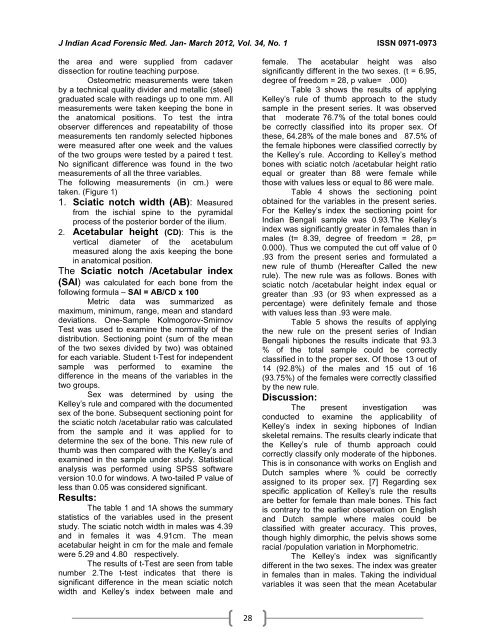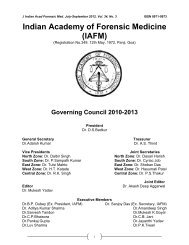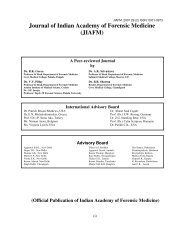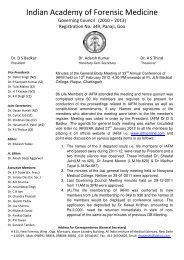Indian Academy of Forensic Medicine (IAFM) - Official website of IAFM
Indian Academy of Forensic Medicine (IAFM) - Official website of IAFM
Indian Academy of Forensic Medicine (IAFM) - Official website of IAFM
Create successful ePaper yourself
Turn your PDF publications into a flip-book with our unique Google optimized e-Paper software.
J <strong>Indian</strong> Acad <strong>Forensic</strong> Med. Jan- March 2012, Vol. 34, No. 1 ISSN 0971-0973<br />
the area and were supplied from cadaver<br />
dissection for routine teaching purpose.<br />
Osteometric measurements were taken<br />
by a technical quality divider and metallic (steel)<br />
graduated scale with readings up to one mm. All<br />
measurements were taken keeping the bone in<br />
the anatomical positions. To test the intra<br />
observer differences and repeatability <strong>of</strong> those<br />
measurements ten randomly selected hipbones<br />
were measured after one week and the values<br />
<strong>of</strong> the two groups were tested by a paired t test.<br />
No significant difference was found in the two<br />
measurements <strong>of</strong> all the three variables.<br />
The following measurements (in cm.) were<br />
taken. (Figure 1)<br />
1. Sciatic notch width (AB): Measured<br />
from the ischial spine to the pyramidal<br />
process <strong>of</strong> the posterior border <strong>of</strong> the ilium.<br />
2. Acetabular height (CD): This is the<br />
vertical diameter <strong>of</strong> the acetabulum<br />
measured along the axis keeping the bone<br />
in anatomical position.<br />
The Sciatic notch /Acetabular index<br />
(SAI) was calculated for each bone from the<br />
following formula – SAI = AB/CD x 100<br />
Metric data was summarized as<br />
maximum, minimum, range, mean and standard<br />
deviations. One-Sample Kolmogorov-Smirnov<br />
Test was used to examine the normality <strong>of</strong> the<br />
distribution. Sectioning point (sum <strong>of</strong> the mean<br />
<strong>of</strong> the two sexes divided by two) was obtained<br />
for each variable. Student t-Test for independent<br />
sample was performed to examine the<br />
difference in the means <strong>of</strong> the variables in the<br />
two groups.<br />
Sex was determined by using the<br />
Kelley’s rule and compared with the documented<br />
sex <strong>of</strong> the bone. Subsequent sectioning point for<br />
the sciatic notch /acetabular ratio was calculated<br />
from the sample and it was applied for to<br />
determine the sex <strong>of</strong> the bone. This new rule <strong>of</strong><br />
thumb was then compared with the Kelley’s and<br />
examined in the sample under study. Statistical<br />
analysis was performed using SPSS s<strong>of</strong>tware<br />
version 10.0 for windows. A two-tailed P value <strong>of</strong><br />
less than 0.05 was considered significant.<br />
Results:<br />
The table 1 and 1A shows the summary<br />
statistics <strong>of</strong> the variables used in the present<br />
study. The sciatic notch width in males was 4.39<br />
and in females it was 4.91cm. The mean<br />
acetabular height in cm for the male and female<br />
were 5.29 and 4.80 respectively.<br />
The results <strong>of</strong> t-Test are seen from table<br />
number 2.The t-test indicates that there is<br />
significant difference in the mean sciatic notch<br />
width and Kelley’s index between male and<br />
28<br />
female. The acetabular height was also<br />
significantly different in the two sexes. (t = 6.95,<br />
degree <strong>of</strong> freedom = 28, p value= .000)<br />
Table 3 shows the results <strong>of</strong> applying<br />
Kelley’s rule <strong>of</strong> thumb approach to the study<br />
sample in the present series. It was observed<br />
that moderate 76.7% <strong>of</strong> the total bones could<br />
be correctly classified into its proper sex. Of<br />
these, 64.28% <strong>of</strong> the male bones and 87.5% <strong>of</strong><br />
the female hipbones were classified correctly by<br />
the Kelley’s rule. According to Kelley’s method<br />
bones with sciatic notch /acetabular height ratio<br />
equal or greater than 88 were female while<br />
those with values less or equal to 86 were male.<br />
Table 4 shows the sectioning point<br />
obtained for the variables in the present series.<br />
For the Kelley’s index the sectioning point for<br />
<strong>Indian</strong> Bengali sample was 0.93.The Kelley’s<br />
index was significantly greater in females than in<br />
males (t= 8.39, degree <strong>of</strong> freedom = 28, p=<br />
0.000). Thus we computed the cut <strong>of</strong>f value <strong>of</strong> 0<br />
.93 from the present series and formulated a<br />
new rule <strong>of</strong> thumb (Hereafter Called the new<br />
rule). The new rule was as follows. Bones with<br />
sciatic notch /acetabular height index equal or<br />
greater than .93 (or 93 when expressed as a<br />
percentage) were definitely female and those<br />
with values less than .93 were male.<br />
Table 5 shows the results <strong>of</strong> applying<br />
the new rule on the present series <strong>of</strong> <strong>Indian</strong><br />
Bengali hipbones the results indicate that 93.3<br />
% <strong>of</strong> the total sample could be correctly<br />
classified in to the proper sex. Of those 13 out <strong>of</strong><br />
14 (92.8%) <strong>of</strong> the males and 15 out <strong>of</strong> 16<br />
(93.75%) <strong>of</strong> the females were correctly classified<br />
by the new rule.<br />
Discussion:<br />
The present investigation was<br />
conducted to examine the applicability <strong>of</strong><br />
Kelley’s index in sexing hipbones <strong>of</strong> <strong>Indian</strong><br />
skeletal remains. The results clearly indicate that<br />
the Kelley’s rule <strong>of</strong> thumb approach could<br />
correctly classify only moderate <strong>of</strong> the hipbones.<br />
This is in consonance with works on English and<br />
Dutch samples where % could be correctly<br />
assigned to its proper sex. [7] Regarding sex<br />
specific application <strong>of</strong> Kelley’s rule the results<br />
are better for female than male bones. This fact<br />
is contrary to the earlier observation on English<br />
and Dutch sample where males could be<br />
classified with greater accuracy. This proves,<br />
though highly dimorphic, the pelvis shows some<br />
racial /population variation in Morphometric.<br />
The Kelley’s index was significantly<br />
different in the two sexes. The index was greater<br />
in females than in males. Taking the individual<br />
variables it was seen that the mean Acetabular









